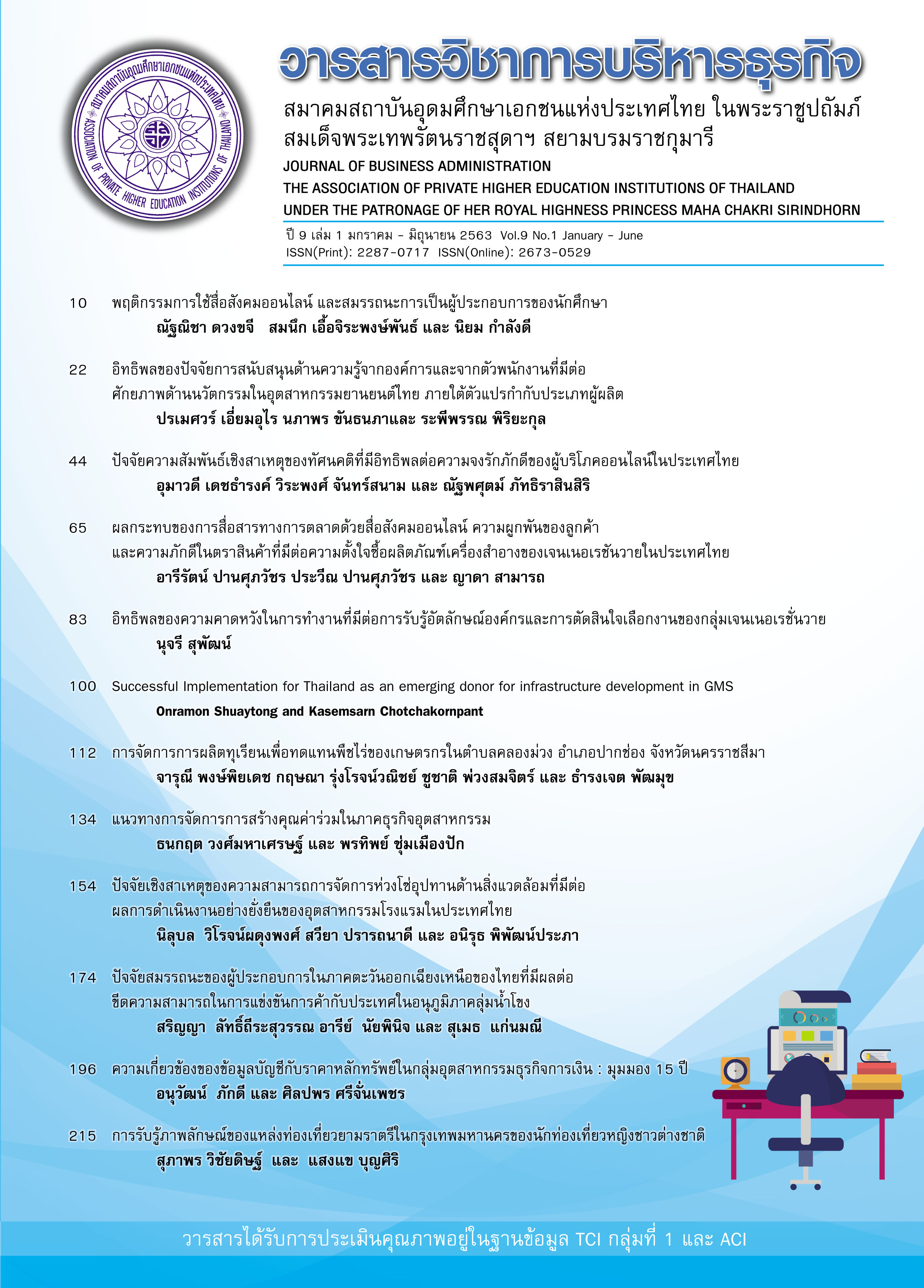แนวทางการจัดการการสร้างคุณค่าร่วมในภาคธุรกิจอุตสาหกรรม
คำสำคัญ:
การสร้างคุณค่าร่วม, , การมีส่วนร่วมของประชาคม,, การจัดการความรู้, ความเพียงพอของทรัพยากร, การตลาดสร้างสรรค์บทคัดย่อ
วัตถุประสงค์ของการวิจัย เพื่อพัฒนาแบบจำลองสมการโครงสร้างแนวทางการจัดการ การสร้างคุณค่าร่วม
ของภาคธุรกิจอุตสาหกรรมจดทะเบียนในตลาดหลักทรัพย์แห่งประเทศไทย โดยกลุ่มตัวอย่างการวิจัย คือ ผู้ประกอบ
การภาคธุรกิจอุตสาหกรรมที่จดทะเบียนในตลาดหลักทรัพย์แห่งประเทศไทยและมีประสบการณ์การดำเนินการเกี่ยว
กับการจัดการการสร้างคุณค่าร่วม จำนวน 500 คน เครื่องมือที่ใช้ในการวิจัยเป็นแบบสอบถามที่มีเนื้อหาเกี่ยวข้อง
กับแนวทางการจัดการการสร้างคุณค่าร่วมภาคธุรกิจอุตสาหกรรมที่จดทะเบียนในตลาดหลักทรัพย์แห่งประเทศไทย
และวิเคราะห์ด้วยแบบจำลองสมการโครงสร้าง
ผลการวิจัยพบว่า องค์ประกอบของแบบจำลองสมการโครงสร้างแนวทางการจัดการ การสร้างคุณค่าร่วม
ของภาคธุรกิจอุตสาหกรรมที่จดทะเบียนในตลาดหลักทรัพย์แห่งประเทศไทย ประกอบด้วยตัวแปรแฝงภายนอกมี 1
องค์ประกอบ คือ การมีส่วนร่วมของประชาคม และตัวแปรแฝงภายในมี 4 องค์ประกอบ คือ ความเพียงพอของ
ทรัพยากร การจัดการความรู้ การตลาดสร้างสรรค์ และนวัตกรรม โดยทั้ง 5 องค์ประกอบของแนวทางการจัดการที่
พัฒนาขึ้นมีความสอดคล้องกับข้อมูลเชิงประจักษ์โดยมีค่า p ของ Chi-Square = 0.146, CMIN/DF = 1.123,
GFI = 0.967 และ RMSEA = 0.016 อย่างมีนัยสำคัญทางสถิติที่ระดับ .05 แนวทางการจัดการการสร้างคุณค่าร่วม
กันของภาคธุรกิจอุตสาหกรรมที่ จดทะเบียนในตลาดหลักทรัพย์แห่งประเทศไทยต่างมีความสัมพันธ์ทางบวกให้
ค่าสัมประสิทธิ์เส้นทาง 0.42 0.81 0.99 0.55 และ 0.84 ตามลำดับ ผลที่ได้จาการวิเคราะห์ดังกล่าวทำให้เกิดคุณค่า
ที่ดีของการสร้างคุณค่าร่วมของภาคธุรกิจอุตสาหกรรมที่จดทะเบียนในตลาดหลักทรัพย์แห่งประเทศไทยและการดำรง
คงอยู่ของการดำเนินธุรกิจสืบต่อไป
References
Alcott, B., Giampietro, M., Mayumi, K., & Polimeni, J. (2012). The Jevons paradox and the myth of resource efficiency improvements. New York: Earthscan.
Alvarez, S. A., & Barney, J. B. (2017). Resource based theory and the entrepreneurial firm. In M. A. Hitt, D.R. Ireland, M.S. Camp., & D.L. Sexton (Eds.), Strategic entrepreneurship: Creating a new mindset (pp. 87-105). New Jersey: Blackwell Publishing Ltd.
Collison, C., & Parcell, G. (2003). Learning to fly: Practical lessons from some of the world's leading knowledge companies (2nd ed.). Oxford: Capstone.
Comrey, A. L., & Lee, H. B. (1992). Interpretation and application of factor analytic results. In A. L.
Comrey., & H. B. Lee (Eds.), A first course in factor analysis (pp. 2). Hillsdale, New Jersey: Lawrence Eribaum Associates.
Corazza, L., Scagnelli, S. D., & Mio, C. (2017). Simulacra and sustainability disclosure: analysis of the interpretative models of creating shared value. Corporate Social Responsibility and Environmental Management, 24(5), 414-434.
Damanpour, F. (1992). Organizational size and innovation. Organization Studies, 13(3), 375-402.
Kimberly, J. R., & Evanisko, M. J. (1981). Organizational innovation: the influence of individual, organizational, and contextual factors on hospital adoption of t e c h n o l o g i c a l a n d administrative innovations. Academy of Management Journal, 24(4), 689-713.
Koelen, M., Eriksson, M., & Cattan, M. (2017). Older people, sense of coherence and community. In the handbook of salutogenesis (pp. 137-149). Springer, Cham.
Kotler, P., & Armstrong, G. (2008). Principles of Marketing (12th ed.). Englewood Cliffs, New Jersey: Pearson Prentice Hall.
Kotler, P., & Keller, K. (2015). Marketing management plus my lab marketing with Pearson e-text access Card. New Jersey: Prentice Hall.
Kramer, M. R., & Porter, M. (2011). Creating shared value. Harvard Business Review, 89(1/2), 62-77.
Kreckova, Z. (2015). Corporate response to concept of shared value. European Scientific Journal, 11(22). 36-45
Kroupová, Z. K. (2015). Shared value and its regional and industrial reflection in corporate projects. Central European Business Review, 4(3), 13-22.
Marres, N. (2016). Material participation: technology, the environment and everyday publics. London: Springer.
Maslow, A. H. (1998), Maslow on management. United State of America: John Wiley & Sons Inc.
Mc Nichol, T. (2005). Creative marketing strategies in small museums: up close and innovative. International Journal of Nonprofit and Voluntary Sector Marketing, 10(4), 239-247.
Montano, D. E., & Kasprzyk, D. (2015). Theory of reasoned action, theory of planned behavior, and the integrated behavioral model. Health Behavior: Theory, Research and Practice, (pp.95-124). New Jersey: John Wiley & Sons.
Mongsawad, P. (2012). The philosophy of the sufficiency economy: a contribution to the theory of development. Asia-Pacific Development Journal, 17(1), 123-143.
Namada, J. M. (2018). Organizational learning and competitive advantage. In Handbook of research on knowledge management for contemporary business environments (pp. 86-104). Pennsylvania: IGI Global Plublisher.
Noe, R. A., Hollenbeck, J. R., Gerhart, B., & Wright, P. M. (2017). Human resource management: Gaining a competitive advantage. New York: McGraw-Hill Education.
Nonaka, I., & Takeuchi, H. (1995). The knowledge-creating company: How Japanese companies create the dynamics of innovation. New York: Oxford university press.
North, K., & Kumta, G. (2018). Knowledge management: value creation through organizational learning. London: Springer.
Porter, M. E., & Kramer, M. R. (2019). Creating shared value. In Managing sustainable business (pp. 323-346). Springer, Dordrecht.
Pierce, J. L., & Delbecq, A. L. (1977). Organization structure, individual attitudes and innovation. Academy of Management Review, 2(1), 27-37.
Sanoff, H. (1999). Community participation methods in design and planning. New York: John Wiley & Sons.
Songsom, A. (2013). The proposed conceptual model of the affecting corporate social responsibility on customer loyalty. WMS Journal of Management, 2(1), 41-54.
Schneider, S., & Spieth, P. (2013). Business model innovation: towards an integrated future research agenda. International Journal of Innovation Management, 17(01), 1340001. DOI: 10.1142/S136391961340001X
Silpcharu, T. (2012). Research and Statistical Analysis with SPSS (11th). Bangkok: Business R&D.
Szpirglas, C., & Eriksson, E. (2015). Beyond CSR, SMEs’ engagement in creating shared value. Sweden: Umeå University
Teerakasemsuk, P. (2015). Media exposure, attitudes and avoidance behaviors in mobile application advertising of Thai teenagers (master’s thesis). Burapha University: Chonburi.
Tiwana, A. (2000). The knowledge management toolkit: practical techniques for building a knowledge management system. New Jersey: Prentice Hall PTR.
The Stock Exchange of Thailand (2017). Classification of industry group and sector. Retrieved from https://www.set.or.th/th/regulations/simplified_regulations/industry_sector_p1.html
Thai CSR Network. (2017).Creating Shared Value (CSV). Retrieved from http://www.thaicsr.com/2014/03/creating-shared-value-csv.html
Visser, W., & Tolhurst, N. (2017). The world guide to CSR: A country-by-country analysis of corporate sustainability and responsibility. NY: Routledge.
Voegtlin, C., & Scherer, A. G. (2017). Responsible innovation and the innovation of responsibility: Governing sustainable development in a globalized world. Journal of Business Ethics, 143(2), 227-243.
Vongchavalitkul, B. (Eds). (2018). Content marketing exposure of online consumers in Bangkok area [Special issue]. Journal of Business Administration APHEIT, 7(2), 85-94.
Wojcik, P. (2016). How Creating shared value differs from corporate social responsibility. Journal of Management and Business Administration, 24(2), 32-55
Wongprasert, R. (2013). Creating shared value: good practice for society. Executive Journal, 33(3), 75-81.
Wu, W. Y., & Tsai, H. J. (2005). Impact of social capital and business operation mode on intellectual capital and knowledge management. International Journal of Technology Management, 30(1-2), 147-171.
Downloads
เผยแพร่แล้ว
How to Cite
ฉบับ
บท
License
บทความที่ลงตีพิมพ์ในวารสารวิชาการบริหารธุรกิจ สมาคมสถาบันอุดมศึกษาเอกชนแห่งประเทศไทยต้องเป็นบทความที่ไม่เคยได้รับการตีพิมพ์เผยแพร่ หรืออยู่ระหว่างการพิจารณาตีพิมพ์ในวารสารอื่นๆ การละเมิดลิขสิทธิ์เป็นความรับผิดชอบของผู้ส่งบทความโดยตรง

